MAAP x QUOC M3 Review: Subtle improvements to an already great performing shoe, but one notable issue.
More durable than the original model while maintaining its good looks, is this collaboration a worthy update?
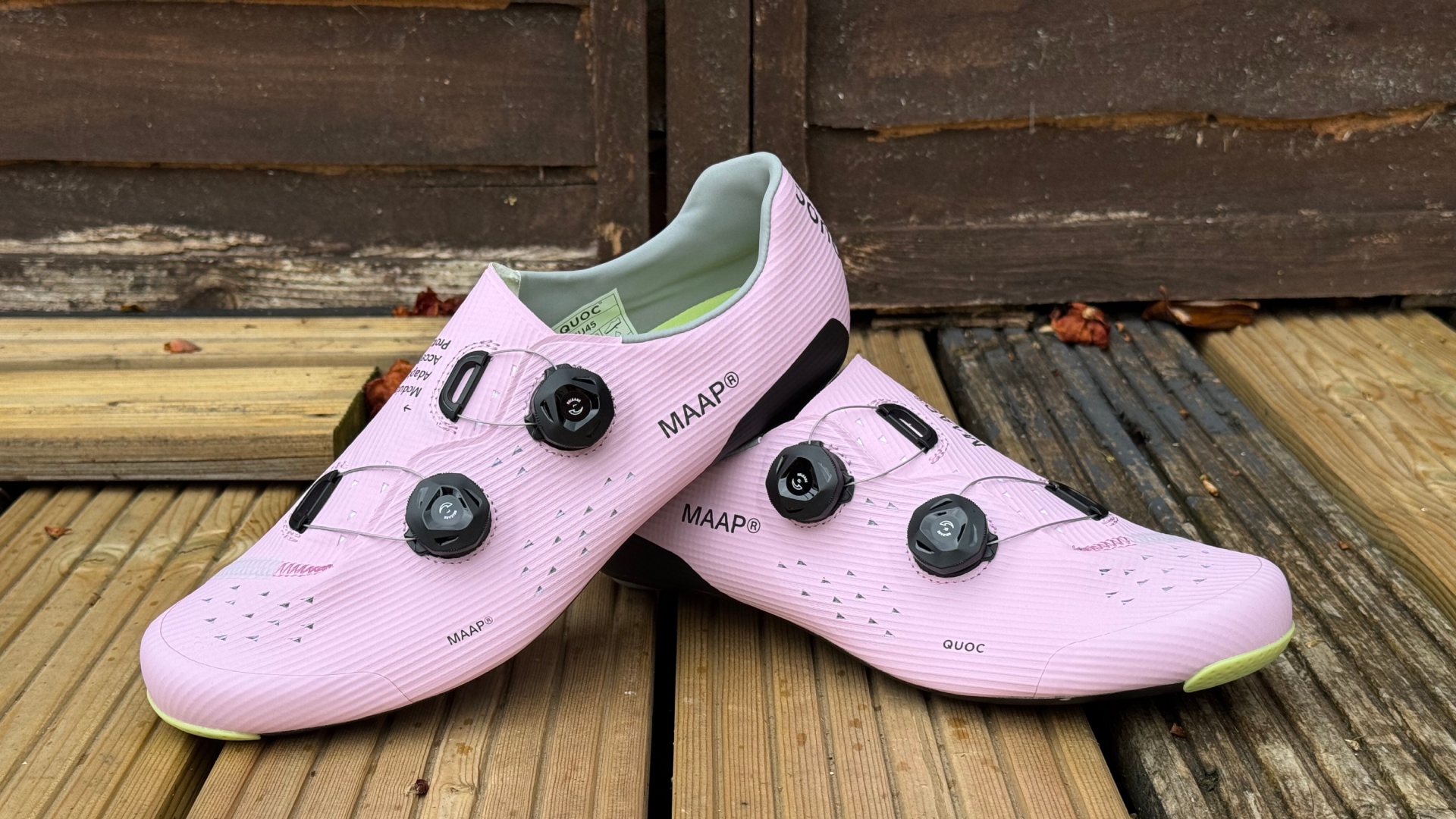
The MAAP x QUOC M3 shoes utilise the same great carbon sole and adjustable insole as the M3 Air and Pro which makes for a superb performance road shoe. Enhanced durability and fun new aesthetics are great additions. However, a less malleable upper with reduced venting can affect comfort, while the retention dials are solid but not class-leading.
-
+
Improved durability over the M3 Air
-
+
Adjustable insole is superb
-
+
Wonderfully stiff
-
+
Aesthetically very attractive
-
+
Doesn’t show dirt as much as the M3 Air
-
-
Retention dials lag behind Boa Li2
-
-
Warmer than the M3 Air model
-
-
Sides are less forgiving than the M3 Air
-
-
No half sizes
You can trust Cycling Weekly.

While the Quoc M3 isn't a brand new offering from the British shoe brand, this collaborative effort with MAAP has a few subtle differences from the original, which make them an interesting proposition. Let's see how they shape up.
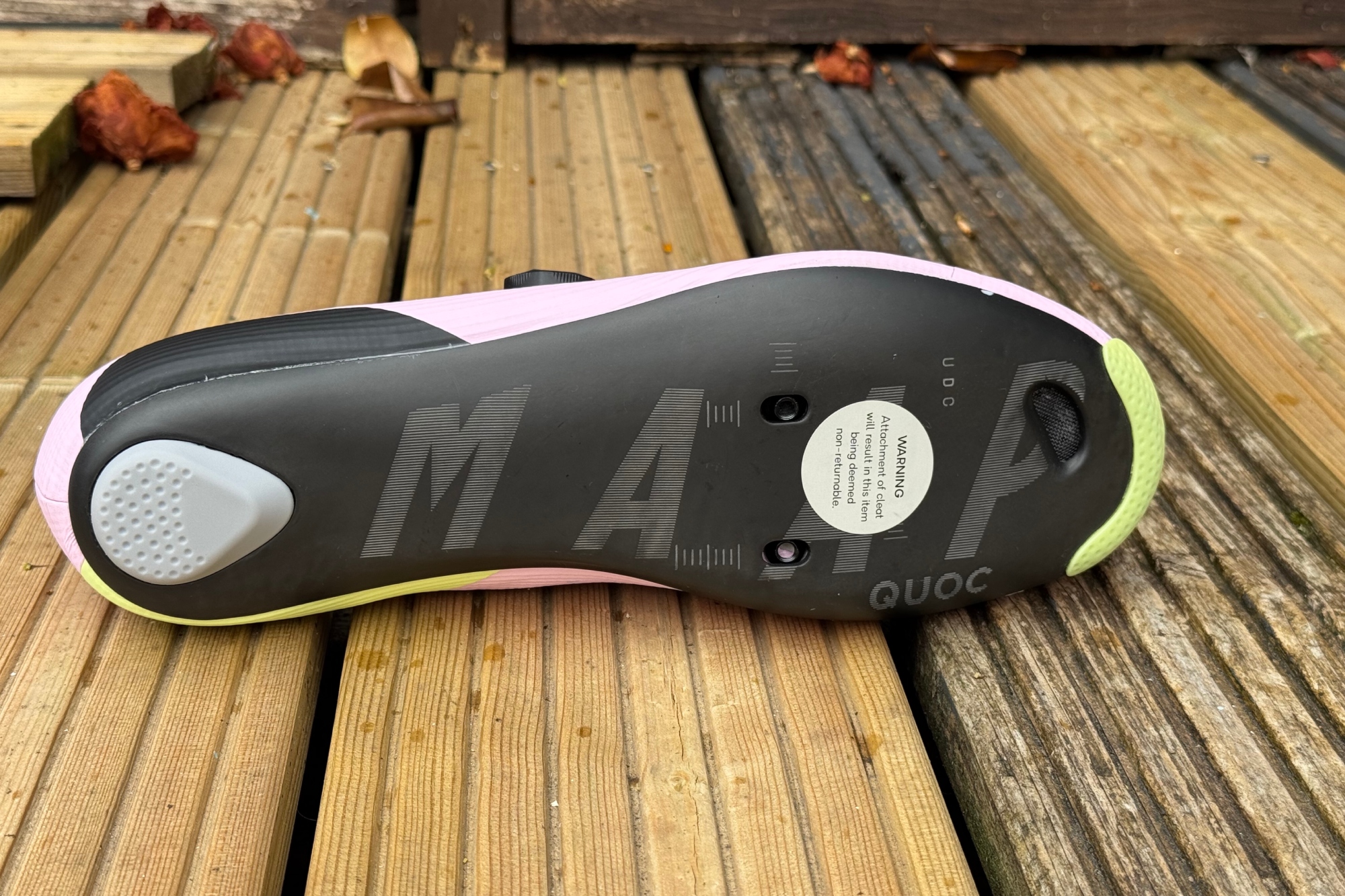
The Maap branding is visible on the carbon outsole, with a neat yellow toe protector and heel protection, to aid walking.
Construction
The foundation of the MAAP x QUOC M3 shoes is the same unidirectional carbon sole that is used across the now expanding M3 range. From the M3 sport, up to the M3 Pro and Air, the same hand laid carbon fibre sole is used. This MAAP edition has the Australian brand's logo etched into it, but that is the only difference.
Cleats are fitted via the industry standard 3-bolt system with fore and aft adjustment while lateral and vertical lines are present for cleat placement guidance. The toe guard is non-replaceable, but the heel guard is, while both are designed to aid traction when walking.
The upper of the shoe is where the M3 Air and Pro differentiate from the more budget friendly Sport version. This upper is made from a laminated mesh TPU (Thermoplastic Polyurethane) which is finely ribbed, according to QUOC to improve aerodynamics.
The MAAP x QUOC M3 features small triangular holes with an open mesh underneath for ventilation across the toe, tongue, and sides. An additional vent is present on the toe of the outsole. This positions it between the M3 Pro and Air designs with this regard, with the Pro using smaller perforations, and the Air featuring an open mesh for ventilation.
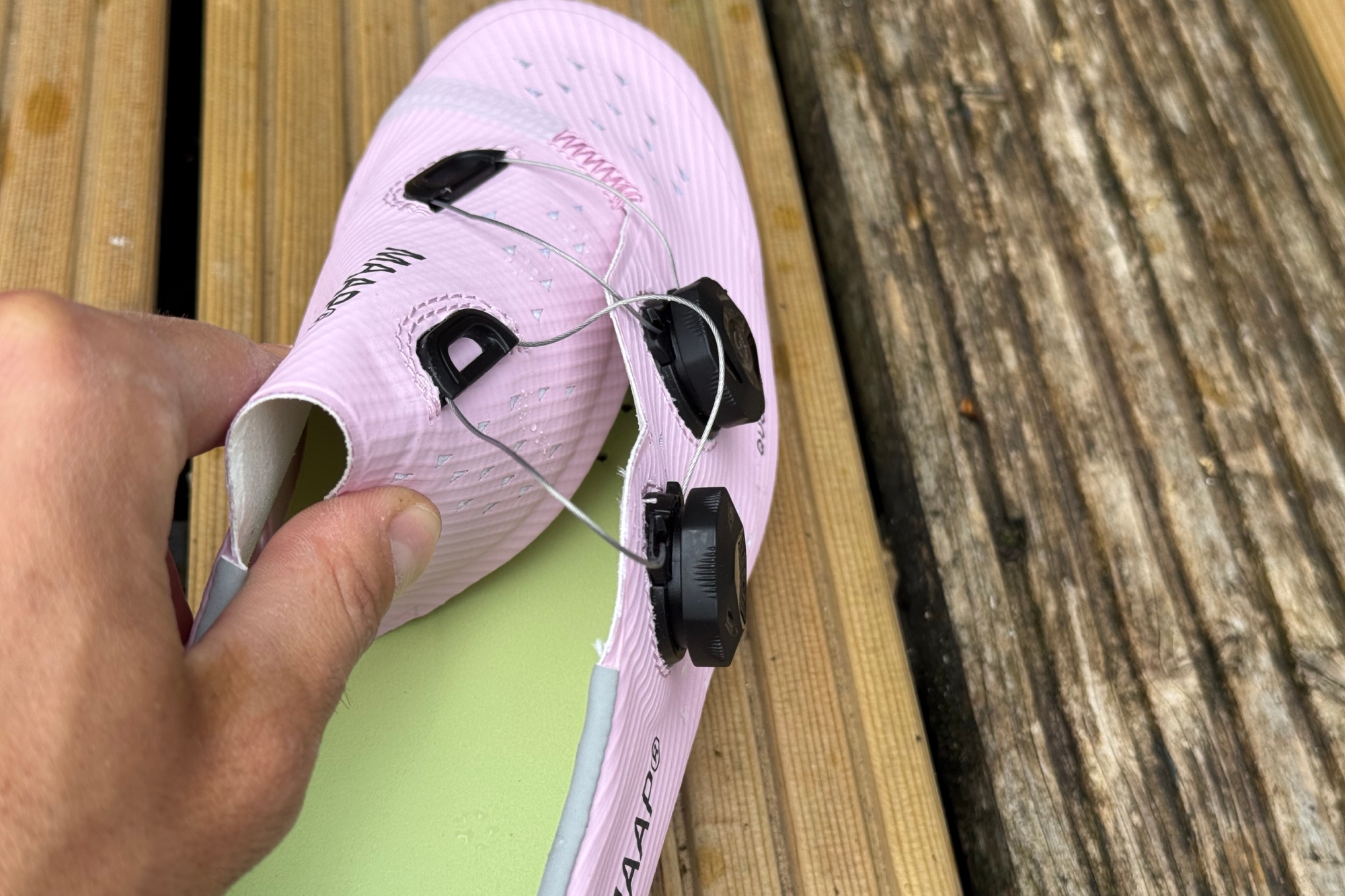
Rather than using a standard tongue design, the M3 shoes feature a wraparound structure where the tongue is a part of the upper material itself.
Rather than using a standard tongue design, the M3 shoes feature a wraparound structure where the tongue is a part of the upper material itself. This is similar to the Shimano S-Phyre RC903 range, and is designed to tailor the fit without pinch points. A welcome update on the M3 Air is now greater reinforcement around the stitching of the two upper pieces together. For adjustments, QUOC uses its own dials which for micro adjustments when tightening, and a twist to release mechanism. Two dials are present on both shoes.
Inside, again similar to Shimano, QUOC uses an adjustable arch support for low, medium, or high arches which are attached simply via double backed tape. This insole is also vibration dampening aimed to improve comfort over longer durations without impacting system stiffness.
The latest race content, interviews, features, reviews and expert buying guides, direct to your inbox!
The MAAP x QUOC M3 is available in both a white colourway with accents, or this pinkish Musk option. It holds a £20 premium over the standard M3 Air and Pro, and comes in sizes 38 to 47 in no half sizes. Claimed weight is 242g per shoe, but came in at 263g per shoe on our scales.
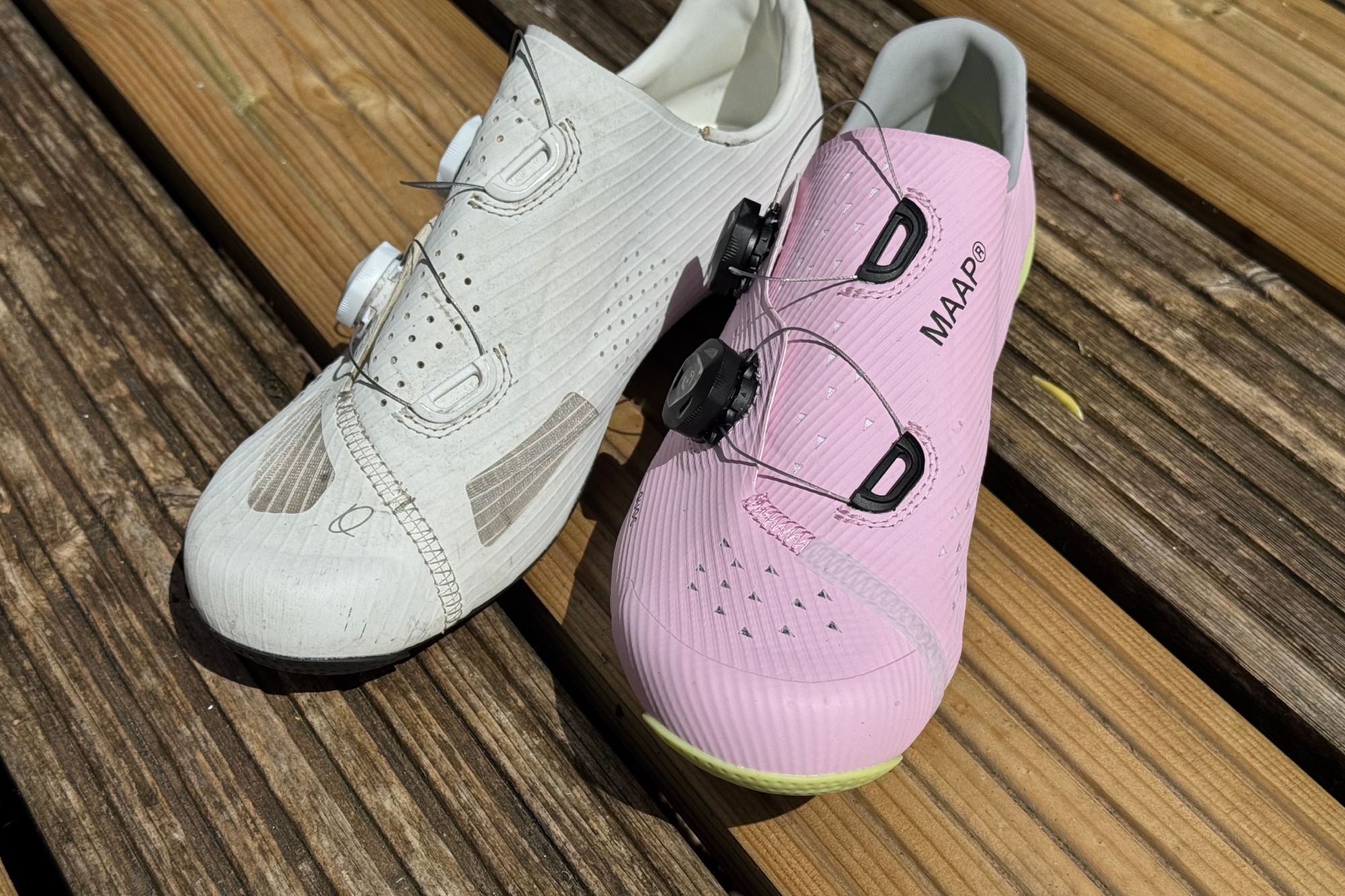
The ride
Fit wise, the MAAP x QUOC M3 share the same geometry as the rest of the M3 line, being somewhat wider than the standard used across most performance road shoes, but a touch narrower than the likes of the S-Works Torch range. They sit really between the Torch shoes and Shimano’s Wide Fit options, which is quite a good middle ground for me personally. Of course fit is rider dependent so it’s always worth trying on before you buy, or walking around on a carpeted surface before attaching the cleats.
Comfort wise the M3 can take a little while to really bed in. I’ve found with both these and the M3 Air that the wraparound tongue can dig into the top of the foot at the sides a little bit on the first couple of rides. However after this bedding in period that was no longer an issue.
In terms of length the shoe is spot on, while at the widest part of my foot there was no discomfort whatsoever. Where there was a slight difference with the M3 Air was more noticeable in warmer weather. There are not quite as many vents, and as a result there was a bit of foot expansion over longer rides in warmer weather. Something I appreciated about the M3 Air was the open mesh used across the inside of the shoe at the widest point which allowed for a bit of expansion. In the MAAP x QUOC M3 I did find that there was a bit of pressure across the outside of my right foot around the little toe as there was not this expansion room, but this was isolated to warmer weather rides over 3 hours long.
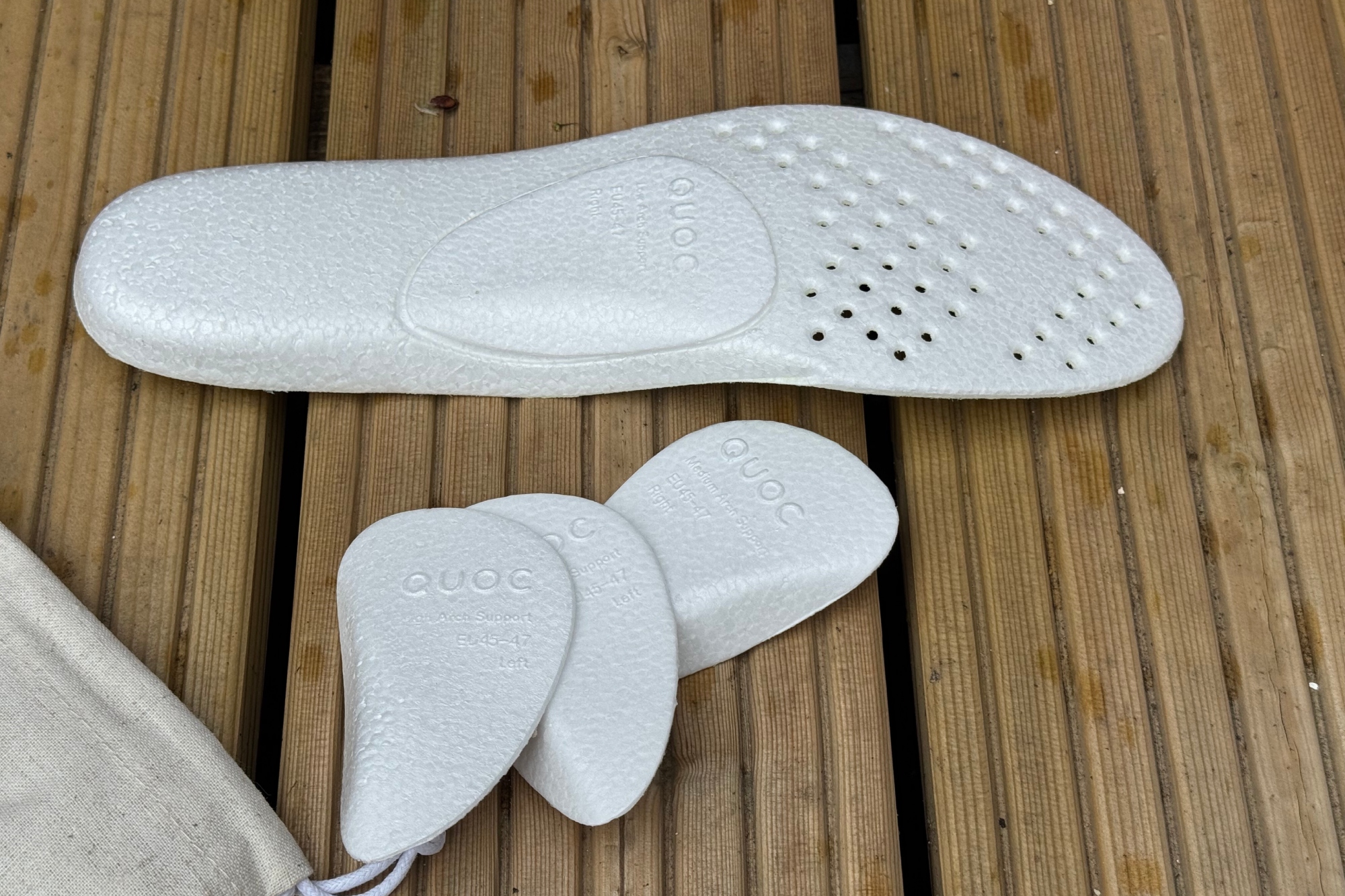
The insoles proved to be really effective . Vibration damping is a useful element which does nothing to detract from the power transfer, but over longer duration rides does reduce any incidence of numbness in the feet. This is a rare occurrence, but I have encountered it over long rides on broken road surfaces with particularly stiff shoes. Having the option to switch out the arch supports is also great, as often with testing shoes I have to use my own insoles in them and hope they fit. With the QUOC the standard insoles with a high arch insert fit pretty much perfectly for me.
This perfect fit of the insoles also does wonders for enhancing the overall system stiffness. The carbon outsole is fantastic when it comes to power transfer, really giving a connected feeling to the pedals when pushing down. But of course the overall stiffness of the shoe is a lot more than just the outsole, it’s about the entire system together. QUOC has done a great job with this, combining a stiff carbon sole with a secure upper and a heel counter that does not allow for any slip. This means that even when mashing the pedals trying to squeeze out every single watt the shoes feel secure on the foot with no wasted effort.
The use of two dials combined with the wraparound tongue also boost this overall system stiffness. The dials are great for clamping down, as tightening is done with small increments for genuine micro-adjustability. However there isn’t any option to loosen them at smaller increments. Rather it's simple 'twist to release', which does allow the foot to escape easily, but means a case of loosening, then retightening if you want to tailor the fit mid-ride. I prefer them to Sidi’s own proprietary retention dials, but the Boa Li2 are still the standard setters when it comes to retention dials.
There are a couple of practical elements where the MAAP x QUOC M3 falls a touch flat. First and foremost, the size range is somewhat limited thanks to the exclusion of any half sizes. When spending £350 / $450 on a pair of shoes, you want to get the fit spot on, and having only full sizes does limit that slightly. QUOC is a smaller scale brand than the likes of industry giants Specialized and Shimano, so there can be some leniency there.
The other practical element is the colour choices, as both are lighter options, which over time will show the dirt. White is definitely a popular choice when it comes to cycling shoes, but a darker colour option like black would be ideal for year round use without becoming dulled by rain and mud.
However, these are balance by some practical features that I do really like. The replaceable heel counter is great, as it is rugged and gives good traction when walking in the café. I also think the toe guard is brilliant as it extends nicely forwards so that when putting a toe down at the light or junction the guard takes the brunt of the road protecting that precious carbon sole.
Value and conclusion
This is a bit of a difficult area for the MAAP x QUOC Pro shoes, as this version comes with a £20/$20 price hike over the standard M3 Pro. Indeed at £320/$430 the shoes offer reasonable value in my experience, as the M3 Air shoes I have tested are still going strong showing good longevity while the M3 Pro and MAAP versions have some features which should enhance that further. The extra £20/$20 really is just for the MAAP design and styling, and doesn’t really bring anything functional to the platform beyond what the M3 Pro already offers. However that can be argued for a lot of higher end named brands which have higher prices purely because of the name. Ultimately £20/$20 is not a huge increase and the design of the shoes is, in my opinion, both eye catching and stylish.
Price-wise they do undercut the likes of the Specialized S-Works Torch, Shimano S-Phyre RC903, Sidi Shot 2S, and many other similarly equipped dual boa dialled performance road shoes. The Sidi Ergo 6 do undercut these at £300 /$400, but personally I prefer the fit and performance of the QUOC M3 shoes. Interestingly one of these shoes main competitors are the cheaper QUOC M3 Sport shoes which use the same carbon sole but for £220 /$270 . The upper is plusher and more comfort focussed though, so does lose some of the overall system stiffness.
The MAAP x QUOC M3 shoes are not a pair of shoes that fall foul of style over substance. They offer great levels of total system stiffness, which makes them a superb high intensity effort shoe that has some great practical features such as the adjustable insole.
However, compared to the standard QUOC M3 Pro, that extra £20/$20 doesn’t bring any additional performance benefits, and is purely an aesthetic update. Add to that the dials being solid but not quite at the same level as Boa Li2 dials, and the value of this collaboration is not quite as appealing as the standard M3 Pro. But for those looking for a distinct style paired with great performance, these shoes are a solid choice if your size is available.
Andy is a Sport & Exercise Scientist, fully qualified and experienced Cycling Coach, Sports Director, Freelance Writer, and Performance Consultant. He spent 3 years riding for a UCI cycling team and 7 years as a BC Elite rider, competing in prestigious events such as the Tour of Britain and the Volta a Portugal.
Graduating with a first-class honours degree in Sport & Exercise Sciences, he continues to pursue his interest in research in the field of Sport Science alongside managing his coaching business, ATP Performance. He also works as a Wind Tunnel operator and Performance Consultant at the Silverstone Sports Engineering Hub, working with individuals, teams, and businesses to optimise performance and develop products.
You must confirm your public display name before commenting
Please logout and then login again, you will then be prompted to enter your display name.
